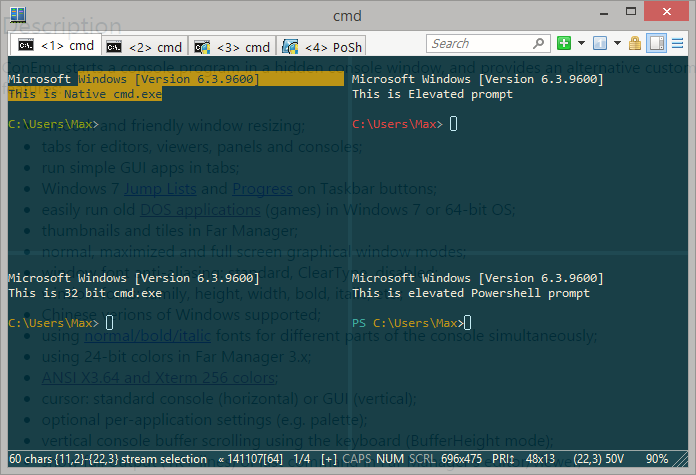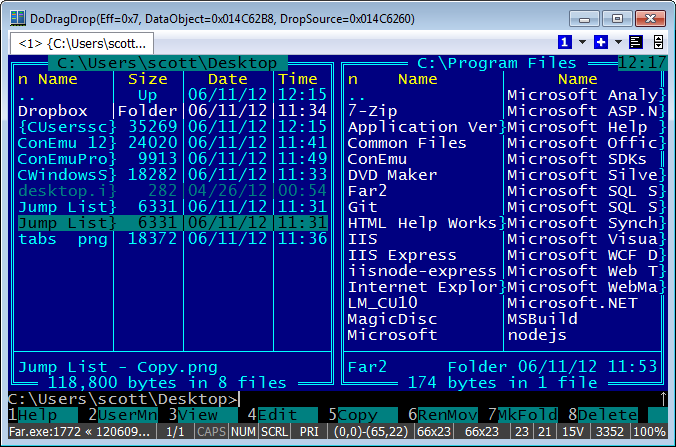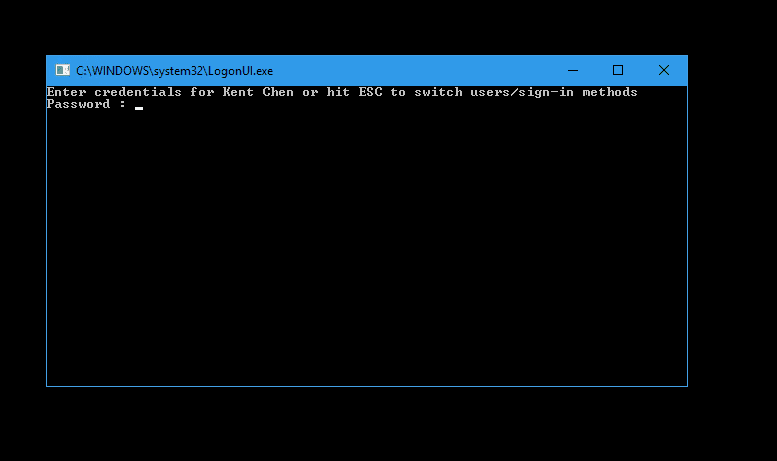Windows 7 Console Mode
One of the most useful tools for fixing problems in Windows 7 and Windows Vista is the Recovery Console, as long as you know where it is and how to activate it.
The Recovery Console is available from either the F8 start-up menu or any Windows installation or recovery disc. Here are the steps to take for starting the Recovery Console from the F8 boot menu:
Jun 24, 2019 Many Windows 7 Command Prompt commands are similar to classic MS-DOS commands. However, the Command Prompt is not MS-DOS and the commands are not MS-DOS commands If you're interested in why a command was removed or when it was first available, you can see every command from MS-DOS through Windows 8 or skip the details and see it all in our one. If neither the Install Windows page nor the System Recovery Options page appear, and you're not asked to press any key, you might need to change some system settings. If you're using the Windows installation disc or USB flash drive, click Repair your computer. Select the Windows installation you want to repair, and then click Next. Using a Windows 7 32-bit client I am trying to create a desktop icon which will allow me to login to a console session of Windows Server 2003. When I open RDP via 'mstsc /admin' and then login to the server it will connect to the console. Jun 08, 2012 Check How do I create a full-screen console program in VC under windows 7 VGA text mode requires driver support and not all drivers still implement it. The following is signature, not part of post Please mark the post answered your question as the answer, and mark other helpful posts as helpful, so they will appear differently to other users. Feb 13, 2017 When running winscp (tried with both 419 and 424, same results) from a network drive in console mode on windows 7 (32 bit ultimate edition), it refuses to connect to any server. Open scp://user:pass@servername.

How to Force Windows to Restart in Safe Mode Open Advanced Startup Options in Windows 10 or Windows 8, assuming you're using one of those operating systems. Since you can't start Windows properly, use method 4, 5, or 6 outlined in that tutorial.
Restart the computer.
After the start-up message appears, press the F8 key.
You must press F8 before Windows starts.
Choose the option Repair Your Computer.
At this point, your computer may start a custom recovery program, such as the Rescue and Recovery tool available on Lenovo PCs. If so, you should either attempt to access the Recovery Console by using this utility.
Click the Next button.
You may be prompted to choose a keyboard layout and language. You usually have no need to change these options.
Choose your username.
If you know the administrator’s password, you can choose Administrator. The password should be the same as on your own user account, though it may not be.
Select only an account that has administrator access.
Type your password and click OK. Lemonade mouth free download game.
A window appears on the screen, listing several repair and recovery options and tools. Your PC may not have these same options. For example, Dell Factory Image Restore appears only on Dell computers. (On other computers, you may find the Recovery Manager option, which is pretty much the same thing.)
Choose the option Command Prompt.
The command prompt window opens. You’re now ready to use the Recovery Console commands.
When you’re done using the command prompt, close its window. Auvio usb to hdmi download.
Choose the option Restart from the System Recovery Options window.
The computer restarts.
In some cases, the preceding steps may not get you to the Recovery Console. You may instead find a special recovery program or another utility. Don’t give up! It’s still possible to access the Recovery Console by using a Windows installation or update disc or the recovery disc that came with your computer. Follow these steps:
Insert the Windows or system recovery disc into your PC’s optical drive. Icloud activation lock bypass download.
Restart the computer.
Download free get data back software. GetDataBack Data Recovery can track them down-for a price. It even works with corrupted drives and those not recognized by Windows. This version only recovers files from FAT drives, but it does offer a search tool for quickly locating a file by its date, name, or size.If you suspect your actual disk is about to bite the dust, you can create a drive image to use during recovery. We can't vouch for how well this core feature works. The utility can't make rescue discs, however, so if you want to do that, you'll need to build yourself a bootable Windows PE disc and add GetDataBack Data Recovery to it-the publisher's Web site has instructions.Although the application proves quite adept at locating deleted files, and you can view their contents, the demo won't recover them.
Choose the option to boot from the CD or DVD.
Work your way through the installation process until you find the option Repair Your Computer.
Don’t worry: Nothing is changed on your computer until you choose to reinstall Windows. But you’re not doing that.
Press the R key to choose the option Repair Your Computer.
If prompted, don’t choose to repair any start-up or boot issues or errors.
You can return to fix any errors later.
Choose the Windows Vista installation from the list.
Click the Next button.
The System Recovery Options window appears.
Choose the Command Prompt option.
Say hello to the Recovery Console.
When you’re done using the command prompt, close its window.
Choose the option Restart from the System Recovery Options window.
The computer restarts.
The Recovery Console isn’t a friendly place. Go there only when you know what you’re doing or when you’re following directions, like the ones given here.
| Other names | Win32 console |
|---|---|
| Developer(s) | Microsoft |
| Repository | github.com/microsoft/terminal/tree/master/src/host |
| Written in | C++ |
| Operating system | Microsoft Windows |
| Platform | IA-32, x86-64, ARM64 |
| Type | Windows API, Terminal emulator |
| License | MIT License |
| Website | docs.microsoft.com/en-us/windows/console/ |
The Windows Console is the Windows API-based infrastructure for text-based user interfaces and console applications in Microsoft Windows. An instance of a Windows Console has a screen buffer and an input buffer, and is available both as a window or in text mode screen, with switching back and forth available via Alt-Enter keys. The latter was not supported in Windows Vista, 7, 8, and 8.1, due to the system not supporting full-screen mode, but was made supported again in Windows 10.
Windows Console instances are typically used for applications that do not need to display images but which might use color. Examples include command-line interface tools; command line interpreters such as Windows Command Prompt, Windows PowerShell; file managers such as Far Manager and Midnight Commander; and editors such as the MS-DOS Editor.
In 2019, the Windows Console infrastructure was open-sourced under the MIT License, alongside Windows Terminal.[1]
- 3Implementations
Window and full screen modes[edit]
A Win32 console application may run in two modes.
One mode places the text in a window and uses an operating system's font rendering. In this mode, an application's interaction with user is controlled by the windowing system. This is analogous to X Window System applications such as xterm.
In a full screen mode Win32 console uses a hardware text mode and uploads a raster font to the video adapter. This is analogous to a text system console. Full screen uses Windows' built-in VGA driver, rather than any installed graphics drivers, unless another driver is VGA-compatible.[2] Therefore, it only supports VGA-compatible text modes, giving it a maximum character resolution of 80 columns by 28 rows.[3] This contrasts with comparable consoles in various other operating systems such as Linux, which are able to display higher resolutions through different drivers. This mode was deprecated in Windows Vista as Windows Display Driver Model (WDDM) ceased to support these VGA modes.[4] It was possible to circumvent this issue by installing a Windows XP display driver;[4] however, Windows 8 and later only accepts WDDM drivers.[5] However, the text-Mode full-screen option was brought back starting with Windows 10.[6]
An application can be instantly switched between these two modes with Alt+Return key combination.
How to download and update xbox 360 latest firmware update Samsung are one of the most desirable gadgets that can be bought on the market as well as it is long lasting, so this is why people need to know how to update android firmware on Samsung. The easiest way to update your console software is to connect to Xbox Live. To update your console by using Xbox Live, all you need is an Internet connection. To connect your Xbox 360 console to the Internet, see the Xbox 360 First-Time Connection Solution. Press the Guide button on your controller, go to settings, and then select System Settings. If you want to manually update your console through USB or the Disc-drive then follow this simple guide. The easiest way to update is for sure through your Xbox Live account. If you want to use Xbox Live to update your console, you need a internet connection. How to make a connection from your Xbox Download Latest Xbox 360 Dashboard Update for USB-stick or CD-Rom Read More ». Apr 25, 2012 If you want to manually update your console through USB or the Disc-drive then follow this simple guide. The easiest way to update is for sure through your Xbox Live account. If you want to use Xbox Live to update your console, you need a internet connection. How to make a connection from your Xbox Read More »Download Latest Xbox 360 Dashboard Update for USB-stick or CD-Rom. Learn about the most current system update for the Xbox 360 operating system, and find out what was updated or added. Plug in any external USB hard drive up to 2 TB to store your Xbox 360 downloads, profile, saved games and other data. New or updated features. Xbox One Games with Gold on Xbox 360. Xbox 360 dashboard update.
Details[edit]

The input buffer is a queue where events are stored (from keyboard, mouse etc.). The output buffer is a rectangular grid where characters are stored, together with their attributes. A console window may have several output buffers, only one of which is active (i.e. displayed) for a given moment.
The console window may be displayed as a normal window on the desktop, or may be switched to full screen to use the actual hardware text mode, if a video driver permits a chosen screen size. The display mode is locked in background intensity mode, thus blinking does not work. Also, the underscore attribute is not available.
Programs may access a Win32 console either via high-level functions (such as ReadConsole and WriteConsole) or via low-level functions (e.g. ReadConsoleInput and WriteConsoleOutput). These high-level functions are more limited than a Win32 GUI; for instance it is not possible for a program to change the color palette, nor is it possible to modify the font used by the console using these functions.[7]
Win32 console programs are often mistaken for MS-DOS applications, especially on Windows 9x. However, a Win32 Console application is just a special form of a native Win32 application. 32-bit Windows can run MS-DOS programs in Win32 console through the use of the NT Virtual DOS Machine (NTVDM).
In earlier versions of Windows, there is no native support for consoles. Because Windows 3.1 and earlier are merely a graphical interface for MS-DOS, most text programs that ran on earlier Windows versions were actually MS-DOS programs running in a window. To simplify the task of porting applications to Windows, early versions of Visual C++ are supplied with QuickWin, a library that implements basic console functionality inside a regular window. A similar library for Borland C++ was called EasyWin.
Implementations[edit]
Windows 9x[edit]
Windows 9x support is relatively poor compared to Windows NT, because the console window runs in the system virtual DOS machine and so keyboard input to a Win32 console application had to be directed to it by conagent.exe running in a DOS VM that are also used for real DOS applications by hooking the keyboard interrupt. conagent.exe then calls Vcond (which is a VxD). Vcond then had to pass the keyboard input to the System VM, and then finally to the Win32 console application. Besides performance, another problem with this implementation is that drives that are local to a DOS VM are not visible to a Win32 console application. This can cause confusion.
Under Windows 9x, the screen buffer mirrors the structure of VGA text buffer, with two bytes per character cell: one byte for character code, one byte for attributes (the character must be in OEM character set, the attribute is with high-intensity background/no blinking). This speeds up operation considerably if the actual VGA text mode is used.
Windows NT and Windows CE[edit]
Windows 7 Rdp Console Mode
The Client/Server Runtime Subsystem is responsible for Win32 console windows on Windows NT family of operating systems,[8] although since Windows 7 it offloads most of its work to a separate executable, conhost.exe. Further changes came in Windows 8, with the Conhost.exe process now being spawned by the console-based process rather than from Csrss.exe as in Windows 7[9]
Windows 7 Console Mode Free
Under Windows NT and Windows CE, the screen buffer uses four bytes per character cell: two bytes for character code, two bytes for attributes. The character is then encoded in a 16-bit subset of Unicode (UCS-2).[10] For backward compatibility, the console APIs exist in two versions: Unicode and non-Unicode. The non-Unicode versions of APIs can use code page switching to extend the range of displayed characters (but only if TrueType fonts are used for the console window, thereby extending the range of codes available). Even UTF-8 is available as 'code page 65001'[11] (displaying only from the UCS-2 subset of full Unicode[citation needed]).
As of the Windows 10 October 2018 update, the Windows Console has full Unicode support.[12]
See also[edit]
References[edit]

- ^Cinnamon, Kayla (May 6, 2019). 'Introducing Windows Terminal'. Windows Command Line Tools For Developers. Microsoft. Retrieved May 10, 2019.
- ^VGA-Compatible Video Miniport Drivers, 2012-10-16, retrieved 2012-11-14
- ^Julio Sanchez; Maria P. Canton (2003), 'VGA Fundamentals, Part II: DOS Graphics', The PC Graphics Handbook (for C++ Programmers) (Book), CRC Press, p. 125, ISBN0849316782
- ^ ab'Some 16-bit DOS-based Programs and the Command Prompt will not run in full-screen mode in Windows Vista and in Windows 7'. Support. Microsoft. 2011-09-23.
- ^'Roadmap for Developing Drivers for the Windows 2000 Display Driver Model (XDDM)'. Windows Dev Center - Hardware. Microsoft. 16 November 2013. Retrieved 16 December 2013.
XDDM and VGA drivers will not compile on Windows 8 and later versions
- ^Tkachenko, Sergey (2014-11-24). 'Open command prompt fullscreen in Windows 10'. Winaero. Retrieved 2019-07-31.
- ^A hack is available: SetConsolePalette
- ^Microsoft Security Advisory (930181): Exploit Code Published Affecting Windows Client Server Run-Time Subsystem
- ^Yosifovich, Pavel; Ionescu, Alex; Russinovich, Mark E.; Solomon, David A. (2017-05-15). Windows Internals, Part 1: System architecture, processes, threads, memory management, and more (7th Edition). Redmond, Washington: Microsoft Press. p. 67. ISBN9780735684188.
- ^'Console Reference'. Microsoft. 2009. Retrieved 2010-01-01.
- ^'Release Notes'. docs.microsoft.com.
Console: Fix for no output text being displayed in codepage 65001 (utf8)
- ^Turner, Rich (2018-11-15). 'Windows Command-Line: Unicode and UTF-8 Output Text Buffer'. Windows Command Line Tools For Developers. Microsoft. Retrieved 2019-06-14.